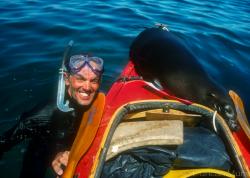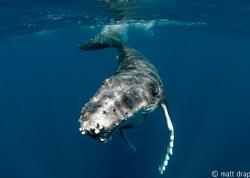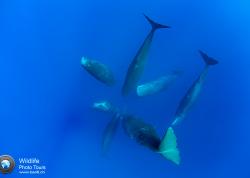Diving the Oil Rigs: An Interview with Milton Love
Diving the Oil Rigs: An Interview with Dr. Milton Love
Dr. Love Shares his Experiences Diving Oil Rigs in Manned Submersibles
By Brent Durand

Oil rig Eureka, located a few miles off the coast of Huntington Beach, CA. Photo: Michael Zeigler
Dr. Milton Love is the authority on fishes of the Pacific Coast. A research biologist at the Marine Science Institute at the University of California, Santa Barbara, Dr. Love has a long history with the dive community. He has worked on various underwater films including Coral Reefs from Jean-Michel Cousteau Productions and the IMAX film The Living Sea, among numerous others. Dr. Love is known to most divers and underwater photographers for his comprehensive (and humorous) book, Certainly More Than You Want to Know About The Fishes of the Pacific Coast.
So what about the oil rigs? What kind of life do we see there and why are they so popular with scuba divers? Dr. Love has spent countless hours manning submersibles on deep dives up and down the coast on a 16-year survey, building a vast knowledge of life flourishing in unlikely (and likely) places. I was able to catch up with Dr. Love recently and get some insight into these experiences.

You grew up in Southern California and received your PHD at UCSB - what attracted you to the ocean in your early years? Well, my dad took me fishing on the Malibu pier when I was about 6. That was about it… I declared I was going to be a fish biologist soon after.
Did you ever expect to have the knowledge about fish that you do now? I don’t think so. If you include grad school, I’ve been in this business almost 40 years. It just creeps up on you.

You were surveying California oil rigs and platforms (via manned submersible) on a 16 year survey finishing in 2011. What fishes do you generally see on the rigs? Well, we didn’t dive the shallowest ones. There are a couple that are in 50 feet of water off Huntington Beach, but if you look at all the rest, the majority of the fish are rockfish of various sorts. In the shallower waters, like at Catalina, there’s garibaldi, sheephead, kelp bass, opaleye and fish like that, but once you get deeper than about 60-80 feet it’s mostly rockfishes. There are 25 or 30 rockfish species, but you’ll also find lingcod and other fish.

Did you ever see anything in deep water in the submersibles that really surprised you? We would see big, unexpected things on almost every dive, both at the rigs and natural reefs. It’s like a fairyland down there. Just last year we were at a site beyond Anacapa Island in about 1200 feet and found all these Humboldt squid. They’re about 4-5 feet long and one actually attacked the sub, grabbing it before spraying ink and taking off. (read our story about a giant pacific octopus stealing a diver’s camera rig).
I guess it didn’t like the lights... It didn’t like the lights or didn’t like the electromagnetic field of the submersible. We’ve taken the sub everywhere from Alaska through California, and if you’re down there long enough you’ll see all kinds of trippy stuff.

So what makes the rigs such a great destination for fish, and in turn, for underwater photographers? Well, the rigs are nothing but humongous reefs. The fish and invertebrates don’t care what they’re made out of. There’s just a lot of life - life that covers the entire water column. If you’re a juvenile rockfish and you’re cruising around 10 feet below the surface looking for a place to settle out, you don’t care if you run into a rock or a piece of steal like a platform. In those areas you’re much more likely to encounter a platform than a reef, so that’s the reason that the platforms tend to be really, really good nursing grounds for young fish. The fish encounter them easily because they cover the entire water column.
The other thing is that platforms tend to be less fished than natural reefs, so they act a little bit like marine reserves and you tend to find bigger fish around the platforms.

In addition to the resident fish population, is it likely to encounter pelagic species? Oh yea, you can find yellow tail and bonita, sardines, jack mackerel, molas and even sea lions. In the Gulf of Mexico you’ll see tunas.
Bluewater Photo has some rigs diving trips coming up, so we really appreciate the great info! Of course. Besides all the fish life, it’s the easiest wall dive you can make in California!

If you’re not familiar with Dr. Milton Love’s book check it out: Certainly More Than You Want to Know About The Fishes of the Pacific Coast.
At time of publishing, spots available for Bluewater Photo’s Oil Rigs trip on April 7, 2013.
About the Author

Brent Durand is an avid California beach diver, underwater photographer and editor with the Underwater Photography Guide. You can follow UWPG on Facebook, and also read Brent's article on Top 10 tips for fun beach diving.
Further Reading
-
California Sea Lions Nursing at the Oil Rigs
-
Shooting Wide-Angle at the Oil Rigs
-
Octopus Steals Diver's Camera
Where to Buy
Please support the Underwater Photography Guide by purchasing your underwater photography gear through our sister site, Bluewater Photo & Video. Click, or call them at (310) 633-5052 for expert advice!
RECOMMENDED ARTICLES
SUPPORT THE UNDERWATER PHOTOGRAPHY GUIDE:
The Best Service & Prices on u/w Photo Gear
 Visit Bluewater Photo & Video for all your underwater photography and video gear. Click, or call the team at (310) 633-5052 for expert advice!
Visit Bluewater Photo & Video for all your underwater photography and video gear. Click, or call the team at (310) 633-5052 for expert advice!
The Best Pricing, Service & Expert Advice to Book your Dive Trips
 Bluewater Travel is your full-service scuba travel agency. Let our expert advisers plan and book your next dive vacation. Run by divers, for divers.
Bluewater Travel is your full-service scuba travel agency. Let our expert advisers plan and book your next dive vacation. Run by divers, for divers.
































